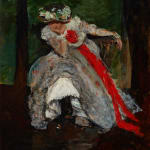Charles Webster Hawthorne 1872-1930
68.6 x 54.6 cm
Framed dimensions: 41 1/2 x 36 in
Like his mentor the great American Impressionist William Merritt Chase, Charles Webster Hawthorne was equally admired in his own day as both a talented painter and a highly influential instructor. Hawthorne first studied with Chase at his Shinnecock Summer School of Art, which was specifically dedicated to open-air landscape painting. Not only did Hawthorne quickly absorb all the principles of Chase’s instruction, but he also became determined to found his own school based on the same model. In 1899 Hawthorne discovered the small fishing village of Provincetown on the furthermost tip of Cape Cod, and after purchasing a large house on Miller Hill, he opened the Cape Cod School of Art, which proved to be an immediate success.
While Hawthorne’s own approach as a teacher owed much to Chase, he developed a distinctly unique painting style and teaching method that defies easy categorization. He was greatly impressed with the work of Franz Hals, which he was exposed to during his trip to Holland in the summer of 1898. Hawthorne was particularly struck by Hals’ Regentesses of the Old Men’s Almhouse, and from this work he absorbed a deep appreciation for the power of human expression and an economy of technique. Hawthorne applied these lessons to his own realistic portraits of Provincetown fishermen and their families; these works have a somber, almost melancholy quality to them, and they reveal a sense of the vulnerability of the human condition.
Stylistically, Hawthorne maintained a life-long commitment to the importance of color. “Beauty in art,” he said, “is the delicious notes of color one against the other.” Of equal importance to him was capturing the effects of light. He told his students: “Everything in painting is a matter of silhouettes. Hold light against shadow, not light against light.” He developed a particular technique of layering glazes and texturing the surface of his paintings, which heightens the relationship between the colors and creates a light effect that seems to emanate from within the painting. These stylistic techniques in combination with his straightforward compositions of one or more figures shown at close range create the hallmarks of Hawthorne’s best paintings.
A period beginning properly in 1902 saw Hawthorne begin to create impressionist figure paintings depicting genteel women. The Red Sash, an early example (c. 1898-1901) of such figure paintings is typical in its extravagantly dressed sitter planted a slight distance back from the viewer. The painting is unusual, however, in its outdoor setting and pronounced display of emotion. In a slightly later and more typical example––also the recipient of the Obrig Prize––The Red Bow (1902), the figure is seated in an interior setting with her head turned downwards. There is an element of mystery; she does not meet the viewer’s eyes and her green and black dress blends in with the dark background. There is certainly feeling attached to the figure, but it is of a calm, quiet sort.
In contrast, The Red Sash practically sings with loud personality; the youthful sort of impatience possessed by the sitter flows from the canvas even though her features are indistinct. Slouching in her seat, one hand propped beneath her chin and the other draped over her chair, the sitter’s restlessness is evident. Hawthorne’s bright red, vibrant green, and earthy brown tones are an ode to his philosophy on color placement, each “note” working together to create a cohesive painting. The bright red of the sitter’s sash speaks to her bright character and the verdant outdoor setting coupled with the Spring flowers on her hat further enforce her youthful personality.
An early example of a series that would become quieter and gentler, The Red Sash is no less telling of the thoughts and feelings of a genteel woman. Hawthorne masterfully captures the essence of a young woman who clearly has things on her mind and places to be, a testament to his talent and deep interest in the portrayal of humanity.
Provenance
H.R. Clarke, New York;Private collection, 1999 until 2024
Please join our mailing list
* denotes required fields
We will process the personal data you have supplied in accordance with our privacy policy (available on request). You can unsubscribe or change your preferences at any time by clicking the link in our emails.



